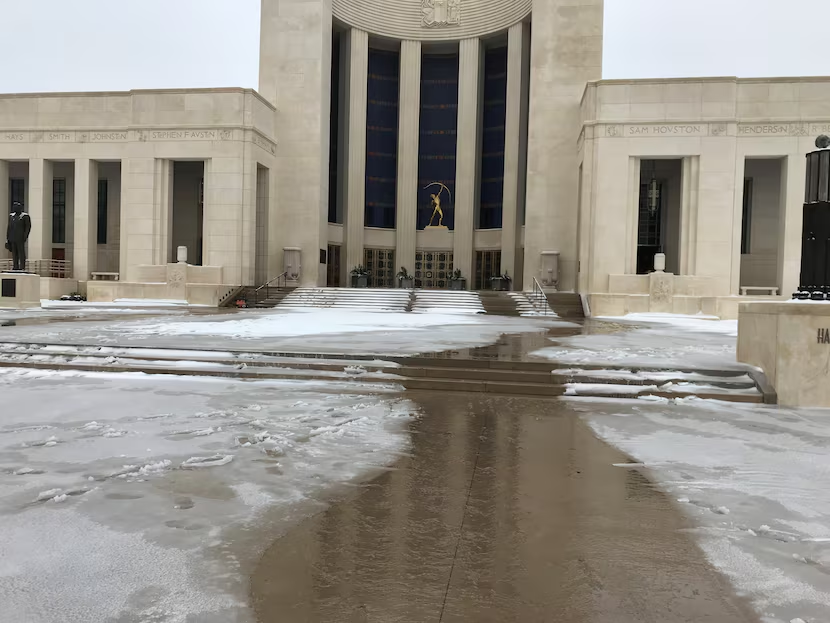On a recent frigid morning, some of the rarest documents in Texas were hit with the terror of a home invasion — by the weather.
They were held hostage for hours, and the future of some remains in peril. They range from a Bible owned by John Neely Bryan, the founder of the city of Dallas, to the Juneteenth proclamation that freed enslaved people in Texas, to a leather pipe bag owned by Comanche leader Quanah Parker.
A Super Bowl football owned by Dallas Cowboys coaching legend Tom Landry stood out among the more sentimental items endangered by the storm, which exacted an emotional toll on those working to save a suddenly imperiled inventory.
For the scores of workers staging the elaborate rescue, the aftereffects linger. For one of them, the crisis began with a peaceful sleep interrupted by a phone call he’ll never forget.
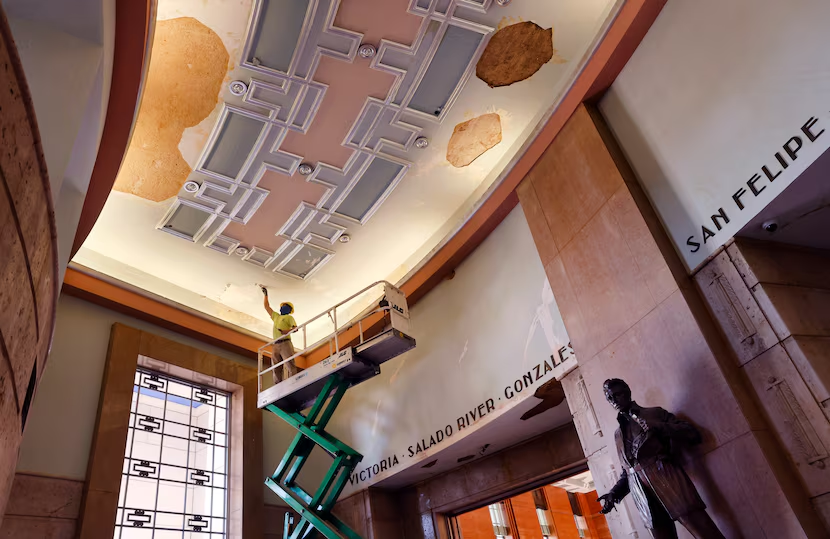
The call came at 4 a.m. Feb. 17, three days after Valentine’s Day, when Toby Hazelip and his colleagues were still feeling giddy about the $14.41 million restoration of the 84-year-old Hall of State finished only two months earlier.
But now, Hazelip would become the trigger man in a whole new restoration. Within minutes, he would be at the forefront of what felt like a war zone, with teams of workers and document preservation specialists battling gushing water, bone-chilling cold and potentially lethal electricity.

Hazelip is exhibits and facilities manager for the Dallas Historical Society, whose collection numbers more than 3 million items. Not all are housed at the Hall of State in Fair Park, but that’s where the middle-of-the-night crisis rapidly unfolded. (An estimated 50,000 items housed in a large warehouse in the Bishop Arts District were spared by the storm known as Uri.)
Uri granted no such mercy to the Hall of State, an architectural icon that commemorates Texas history. The hall opened in September 1936 as the centerpiece of the Texas Centennial.
“This isn’t just any building,” says Veletta Lill, who chairs the Dallas Historical Society and is also a board member of Fair Park First, which manages the 277-acre park that opened in the 1800s.
“The people who work on this building have an emotional investment in this building, whether you work in it or on it,” she says. “This symbolizes Texas. It was built to symbolize Texas. And at the moment, we’re in crisis. Texas is in crisis. So, we feel that pain.”
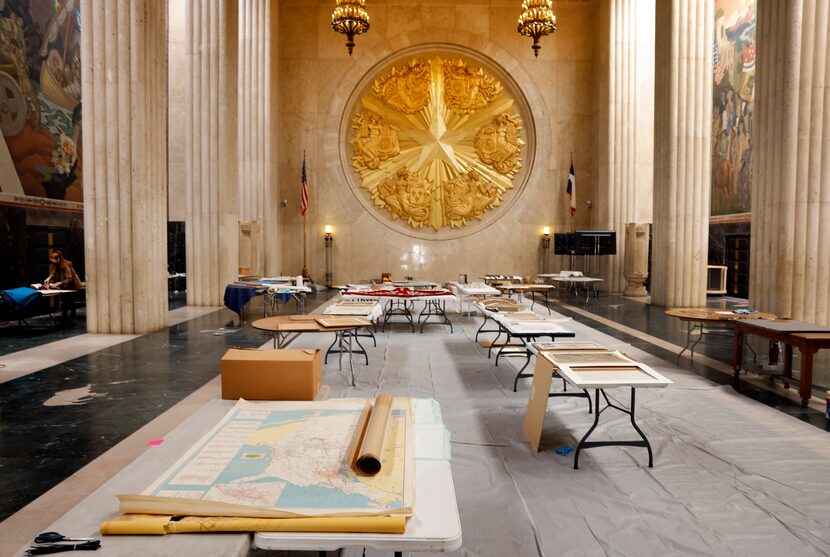
Devastating, yes, but more than a week later, Lill is sounding an optimistic note, believing the contents of the building can and will be saved.
Her optimism extends even to the worst casualties, in particular 18 Orotone photographs, taken by legendary photographer Polly Smith that celebrate the Depression-era history of Texas.
As strange as it sounds, it could have been worse, Lill says, were it not for the fast action by Hazelip and so many others who followed him through the hall’s golden door.

Shaken from slumber, Hazelip walked to his wife’s Ford Explorer and found the windshield already covered with a thick snow. The temperature had fallen to 20 degrees with a plummeting wind chill making it feel even colder.
“Toby arrived at the Hall of State around 4:30 a.m.,” Lill says. “As soon as he got there, he found water gushing from the doors.”
Hearing him tell the story, Lill felt the pain.
“If you were there the first day, and Toby arrived when it was a blizzard, and it was dark, and it was ice. It was,” Lill says, “a stab in the heart. It was truly a stab in the heart.”
All of that is true, abundantly so, Hazelip says. He calls it a highly emotional moment.
What transpired in the days since — repairing walls, floors, pipes, the HVAC system and more — is expected to cost at least $3 million at the Hall of State alone. That doesn’t include damage to the collection or the nearby Cotton Bowl, where repair estimates now exceed $2 million.
So far, rescuers from multiple agencies and private companies have managed to salvage or restore hundreds of documents, one being the historical society’s rarest, most significant item: the 1865 Juneteenth proclamation. It survived, Lill says, because it was locked in a safe. Others are being treated at a Fort Worth facility that specializes in restoring damaged documents.
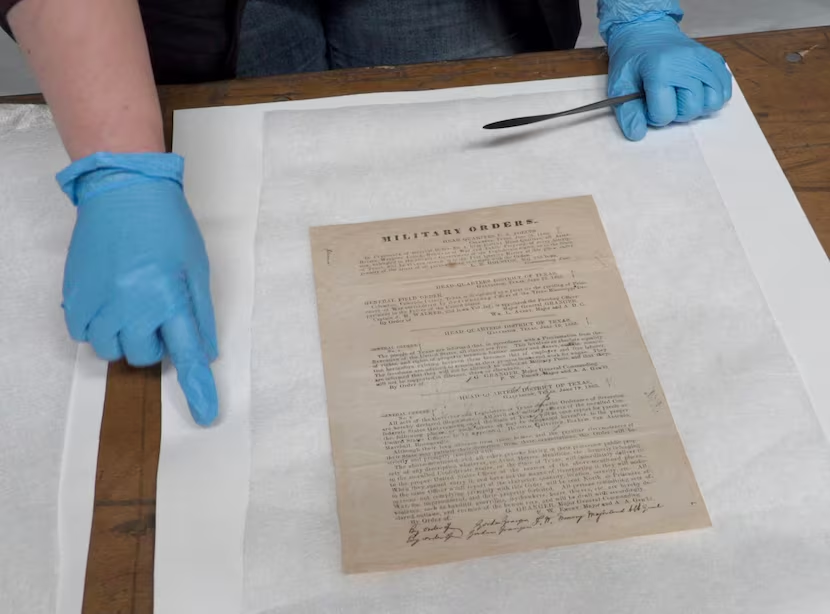
The Dallas Office of Arts and Culture estimates it will cost $411,000 to repair its own damaged or threatened items, which are owned by the City of Dallas and housed in the Hall of State — murals, a fresco, the Orotone photographs, furniture and vitrines.
But the city’s estimate does not include damage to the historical society archives, whose repair costs have not been determined.
All involved say even more items would have been damaged, or destroyed, absent the immediate, widespread response that unfolded soon after Hazelip answered his iPhone at 4 a.m.
By 10 a.m. on Feb. 17, a crew that Lill describes as “a battalion, an army of construction workers” had been deployed. According to Karl Chiao, executive director of the Dallas Historical Society, they worked tirelessly until 9 that night and under the worst possible conditions. Workers were forced to tread carefully, so as not to incur a fatal footstep, because of the mixture of water and power.
“Plus,” Chiao says, “there was always the concern that the ceiling might collapse.”
Chiao offers a grim assessment of what went wrong and why. Heaters designed to keep water pipes from freezing failed to come on. Why? Because rolling blackouts had temporarily taken away the power. “Then at some point,” Chiao says, “the electricity returns, creating an even more dangerous situation. So, there we are, saying, ‘‘Wait, now we have electricity and water spewing out.’ ”
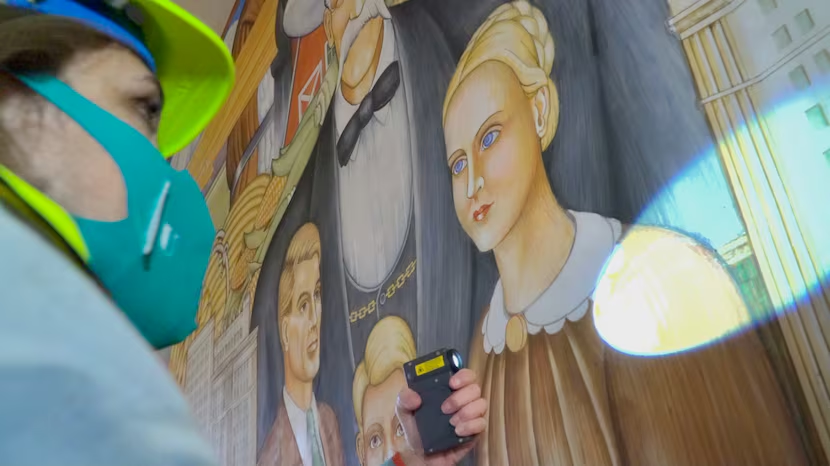
Workers tried and succeeded, Chiao says, to remove 4 feet of water from the boiler room. But even then, the humidity in the building remained far above where it should have been. Instead of being around the ideal 30%, it was easily double that.
“The water in the rest of the building,” Chiao says, “was pumped out by 9″ p.m. on Feb. 17. And then finally, the next day, the outside temperature reached a merciful 32 degrees.
Lynn Rushton, the public art collection and conservation manager for the Dallas Office of Arts and Culture, made a frantic call to the nonprofit document preservation group TX-CERA.
“Think of them,” Lill says, “as the Red Cross for the arts. They’re conservators that respond in emergencies.”
But that wasn’t all. Spectra, which manages operations for Fair Park First, summoned the Michigan-based restoration company Belfor. It dispatched a crew, Lill says, that works with museums “in the case of waterlogged documents.”
Belfor gathered hundreds of items — books and papers mostly — and drove them to Fort Worth, where they “were frozen and freeze-dried,” Lill says, to remove moisture.
Those include a third of the Hall of State’s collection of about 5,000 cartoons drawn by John Knott, an editorial cartoonist for The Dallas Morning News in the early 1900s. Knott drew Old Man Texas, which is found in the mural titled Commerce in the North Texas Room. Lill says that mural will be treated for “a minor intrusion of humidity.”
The G.B. Dealey Library, named for a longtime publisher of The News, is in the West Texas Room, which did not sustain storm damage.
The storm created what Rushton describes, in the 72 hours after Hazelip arrived, as nothing less than “a triage system.”
It felt, she says, “like being in Russia in the 1950s. It’s dark, it’s cold. There’s water everywhere. People are moving around near electrical cords, and scrambling to get objects upstairs to safety.”
Hazelip was not alone in having to weather a sea of emotions. When Rushton arrived at the building, in whose restoration so many had taken such enormous pride, “water was cascading down the front steps of the Hall of State. Those golden doors at the entrance had an iceberg of frozen water that moved all the way down.”
And the bathrooms didn’t work. The Spectra offices in the Tower Building would eventually offer working facilities, as did the African American Museum.
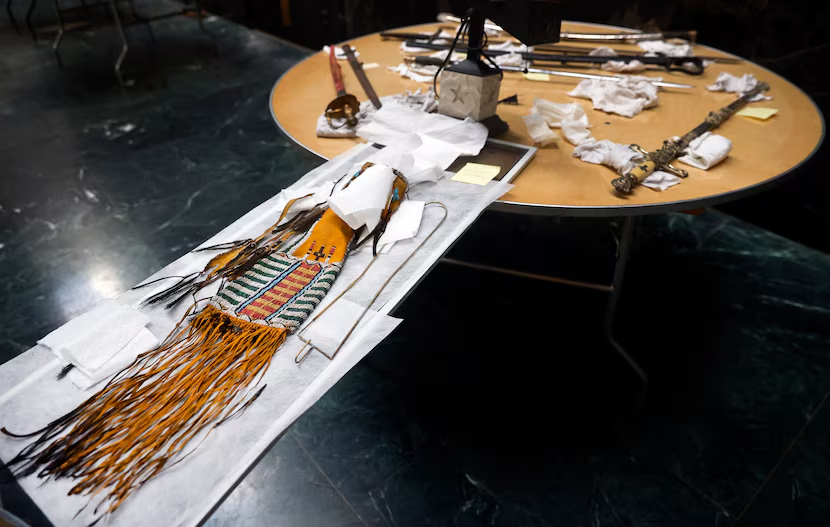
Hazelip credits Phoenix 1, a Farmers Branch restoration and construction company, with a Herculean response that came soon after the arrival of Dallas Fire-Rescue.
“Phoenix 1 called in the cavalry for sure,” Hazelip says.
Chiao credits Phoenix 1 with restoring power to the building by 7 p.m. that Wednesday and with “getting all the water out of the building. They brought generators and heaters and dehumidifiers that were part of our effort to triage the collection.”
Soon, Rushton says, the humidity in the hall went down from a high of 70% to as low as 20%, which she calls “truly impressive.”
Chiao also credits specially designed museum storage cabinets from Spacesaver Corp., which have rubber seals on the top and sides.
“Those cabinets,” Lill says, “are the sole reason that a lot of things were not harmed.”
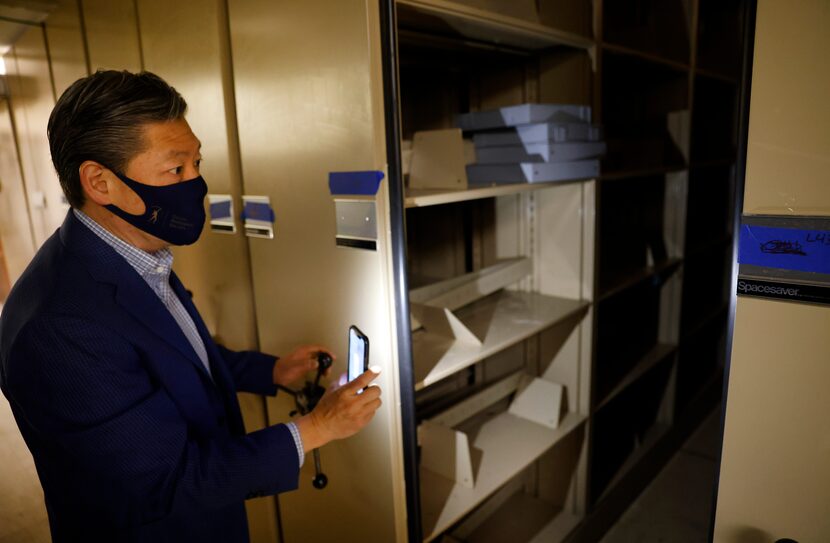
Brian Nicodemus, an architect with Gensler, whose firm oversaw the 2020 renovation, says the swell of emotions surrounding the crisis has not gone away. Winter storm Uri even dealt a cruel hand to a woman who’d hoped to be married in the Hall of State.
“Hours before what figured to be the most important day of her life,” Nicodemus says, “we had to tell her that she would not be able to be married there.”
And that was just one moment in what he called a siege of despair.
“When we left it eight weeks ago,” Nicodemus says, “we felt like it was whole.”
But “whole” soon gave way to broken.
When Chiao arrived at the building at 7 a.m. on Feb. 17, he found Hazelip standing with a plumber, appearing “ready to cry. He looked at me and said, ‘This may be our worst-case scenario.’ "
Hazelip calls that the first moment he let his guard down.
“It was the first time I wasn’t dealing with the situation. It became, in that moment, more discussion than action, so it really started hitting me. And I thought, ‘Man, this is really horrible.’ ”
He was, Chiao says, “visibly shaken. You’re thinking, ‘Oh, my gosh, where do we go from here? This just got done.’ Toby spent the last 12 months of his life doing this. But then he looked at me and said, ‘We built it once. We know how it’s done. Let’s go do it again.’ "
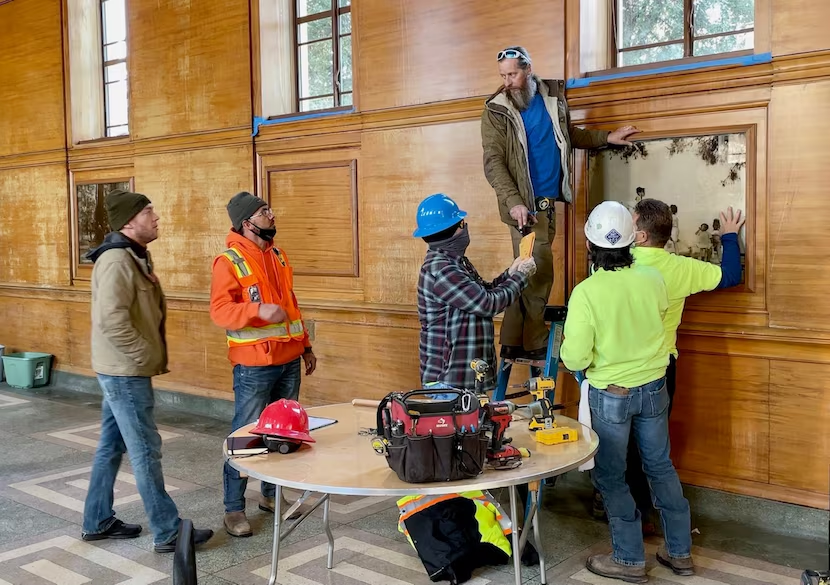
Part of the new mandate is the effort to save Polly Smith’s 18 Orotone photographs, whose fate remains uncertain.
Officials for the Texas Centennial commissioned Smith in 1935 to travel around Texas and make a series of photographs that sought to capture the people and places that made Texas unique. The images coincided with the state’s 100-year anniversary. The photos were created using the Orotone process, in which an image is printed on a glass plate coated with a gelatin emulsion, and have hung in the hall ever since.
Rushton says water invaded the linen tape that seals the three plates of glass that make up each Orotone.
“They are in severe need of conservation, but I think we can repair almost all of them at this point. But it’s an urgent need.”
When Rushton brought in Lyzanne Gann, an independent photography conservator, “The look on her face was urgency. I said, ‘Can you fix these?’ She believes she can. She will do her best to try. These Orotones are extraordinarily rare. This collection we have is priceless, because there’s nothing like it in the entire world.”
For her part, Lill says, “We all feel better today than we did [on Feb. 17]. The items are safe in that building, and we were able to take care of things.”
But, she adds, “I would hope, at some point in the future, that we can lobby to make sure Fair Park never again has its power grid shut off, for days at a time. That, at least, would be a start.”
CORRECTED at 8:30 a.m. Feb. 27 to clarify that TX-CERA is a nonprofit document preservation group.
